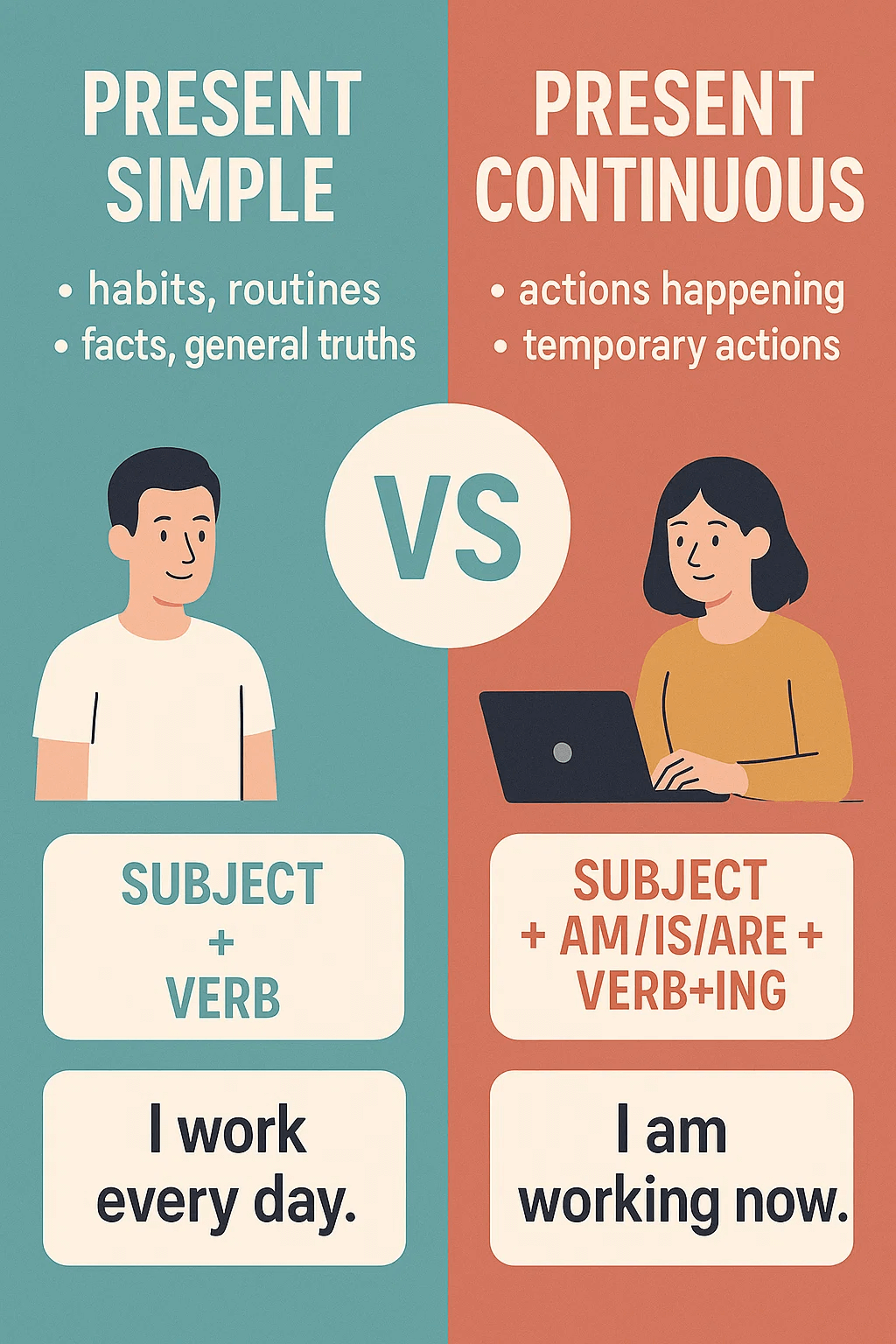Introduction to Present Simple and Present Continuous
The present simple vs present continuous contrast is one of the first big choices learners must make when speaking about the present.
Both tenses talk about “now”, but they focus on different kinds of time. The present simple describes habits, facts, schedules, and permanent states.
The present continuous highlights actions happening right now, temporary situations, developing changes, and planned near-future arrangements. Get this contrast right and your English instantly sounds clearer and more natural.
In this guide, you’ll learn the core rules, see clean examples, study a comparison chart, and practise with a quick quiz. If you don't know a word, check the Glossary below! or try our free dictionary.
Join over 500+ learners
Join the community for free resources and other learning opportunities.
No spam — only valuable English learning content.
Quick Definitions
- Present simple = routine/always true/permanent: I work in Bristol. Trains leave at six.
- Present continuous = happening now/temporary/developing/arranged: I’m working from home today. We’re meeting clients tomorrow.
Forms You Need
Present Simple — Form
- Affirmative: Subject + base verb (add -s/-es for he/she/it)
- I/You/We/They play. | He/She/It plays.
- Negative: do/does + not + base verb
- I do not (don’t) play. | She does not (doesn’t) play.
- Questions: Do/Does + subject + base verb?
- Do you play? | Does he play?
3rd-person spelling tips:
- add -es after ch, sh, ss, x, o (washes, kisses, fixes, goes),
- y → ies after a consonant (studies), but keep -ys after a vowel (plays).
Present Continuous — Form
- Affirmative: am/is/are + verb-ing → I am working; she is reading; they are playing
- Negative: am/is/are + not + verb-ing → I am not waiting; he isn’t coming; they aren’t studying
- Questions: Am/Is/Are + subject + verb-ing? → Are you listening? Is she coming?
-ing spelling tips:
- drop silent e (make → making),
- ie → y (tie → tying),
- double final consonant in stressed CVC (run → running; sit → sitting).
When to Use Each Tense (with clean examples)
Present Simple — Use Cases
- Habits and routines
- I get up at 7 a.m. on weekdays.
- General truths and facts
- Water boils at 100°C.
- Permanent situations and long-term states
- She lives in Manchester.
- Schedules and timetables (fixed by a programme, not by you)
- The flight leaves at 18:40.
- Commentary and headlines (narrative present)
- He shoots, he scores!
Present Continuous — Use Cases
- Actions happening now / around now
- I am writing an email right now.
- Temporary situations (not permanent)
- He is staying with friends this week.
- Developing changes and trends
- Electric car ownership is growing rapidly.
- Arranged future plans (personal diary–style)
- We are meeting the team tomorrow at 10.
- Irritation with “always/constantly” (speaker’s emotion)
- You’re always losing your keys!

Comparison Chart (core differences)
Master Tenses and Boost Your Vocabulary
Learn grammar in context and expand your IELTS vocabulary with 1000 bilingual flashcards designed for Band 7.5+.
Get the FlashcardsSignal Words You’ll Hear
Present Simple — Common markers
always, usually, often, sometimes, rarely, never, every day/week/month, on Mondays, at weekends
Tip: adverbs of frequency usually come before the main verb: I usually eat at home, but after to be: She is usually on time.
Present Continuous — Common markers
now, right now, at the moment, currently, today, this morning/afternoon/evening, this week/month/year, these days
Spoken cues: Look! / Listen! / Be quiet! often signal the continuous: Listen! The baby is sleeping.
Tricky Areas (that cause most mistakes)
1) Temporary vs Permanent
- ❌ I’m living in London. (sounds temporary)
- ✅ I live in London. (long-term fact)
- ✅ I’m living in London for three months. (now it’s clearly temporary)
2) Stative Verbs (usually not continuous)
know, believe, like, love, hate, need, want, understand, remember, prefer, seem, belong
- ❌ I’m knowing the answer.
- ✅ I know the answer.
Exception for polite softeners: I was/were hoping… I’m wondering… (style choice rather than pure state).
3) Schedules vs Personal Plans
- Present simple for fixed timetables: The seminar starts at 11.
- Present continuous for your diary: We are starting the workshop at 11.
4) Always with the Continuous (emotion)
- You’re always leaving lights on! (= complaint/irritation)
5) Commentary vs Description
- Sports/live narration often prefers present simple: He passes, she shoots; but describing what you see right now uses present continuous: He’s running down the wing.
Common Errors & Repairs
- Forgetting 3rd-person -s:
❌ She walk to work. → ✅ She walks to work. - Using continuous for habits:
❌ I’m going to school every day. → ✅ I go to school every day. - Using simple for “now”:
❌ I watch TV now. → ✅ I’m watching TV now. - Stative in continuous:
❌ I’m understanding the question. → ✅ I understand the question. - Confusing timetables and plans:
❌ We meet at 7 (arrangement). → ✅ We’re meeting at 7 (arrangement).
✅ The train leaves at 7 (timetable).
Micro Practice
Rewrite with the correct tense.
- Right now, I (cook) dinner. → Right now, I am cooking dinner.
- She (go) to the gym every Monday. → She goes to the gym every Monday.
- Listen! The birds (sing). → Listen! The birds are singing.
- We (meet) at 10 tomorrow. → We are meeting at 10 tomorrow.
- He (prefer) tea to coffee. → He prefers tea to coffee.
Conclusion
Think of present simple vs present continuous as calendar vs stopwatch. Use the present simple for what is regular, factual, timetabled, or permanent. Use the present continuous for what is happening now, what is temporary, what is changing, or what is arranged in the near future.
With a few signal words and the comparison chart above, your choices become quick and reliable.
👉 Continue exploring our grammar articles for more guides on pronouns and their correct usage:
Past Continuous Tense Explained with Examples
Present Simple vs Present Continuous
Future Perfect Tense Made Easy
Countable vs Uncountable Nouns
Comparatives and Superlatives Exceptions
Conditionals with Unless, Provided That, As Long As
Quantifiers in English Grammar
Glossary (Key Terms)
- Tense (noun) — a verb form that shows time.
- Routine (noun) — something done regularly.
- Temporary (adjective) — lasting for a short time.
- Arrangement (noun) — a planned future meeting/activity.
- Stative verb (noun) — a verb that describes a state (e.g., know).
- Timetable (noun) — a fixed schedule (trains, flights, classes).
- Trend (noun) — a change developing over time.
- Narration (noun) — describing events (e.g., sports commentary).
- Affirmative (adjective) — a positive (not negative/question) sentence.
- Auxiliary (noun) — a helper verb (do/does; am/is/are).
Comprehension Practice
Questions
- Choose the correct sentence for a habit:
a) I’m going to work every day.
b) I go to work every day. - Which is correct for “now”?
a) She speaks to her boss now.
b) She is speaking to her boss now. - True/False: We use present continuous for personal future arrangements.
- Fill the gap: Listen! The children ______ (sing).
- Choose the best option for a timetable:
a) The museum is opening at 10 tomorrow.
b) The museum opens at 10 tomorrow.
Answers
- b
- b
- True
- are singing
- b
Join over 500+ learners
Join the community for free resources and other learning opportunities.
No spam — only valuable English learning content.
